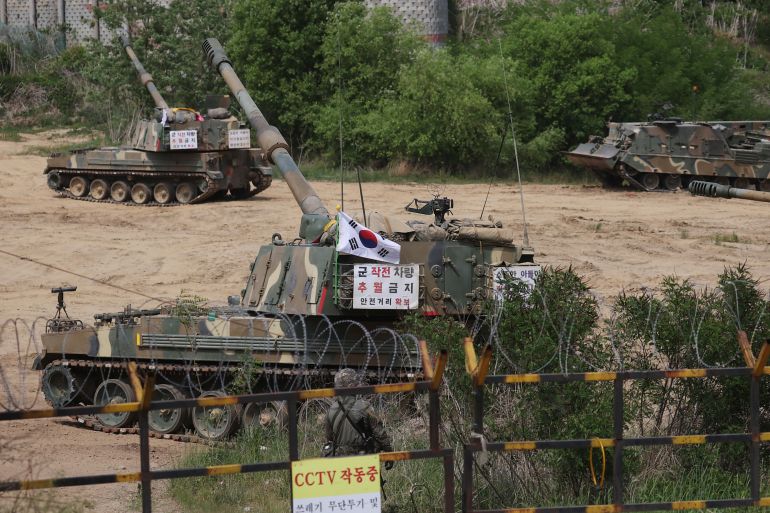Two Koreas exchange warning shots near sea border amid tensions
Moves come amid heightened frictions over a barrage of weapons tests by North Korea.

North and South Korea have exchanged warning shots off their western coast, accusing each other of breaching their maritime border amid heightened tensions over Pyongyang’s weapons tests.
South Korea’s Joint Chiefs of Staff (JCS) said it broadcast warnings and fired warning shots to repel a North Korean merchant vessel that crossed the Northern Limit Line (NLL), the de facto sea boundary, at approximately 3:40am local time on Monday (18:40 GMT Sunday).
Keep reading
list of 4 itemsN Korea fires artillery shells in ‘grave warning’ to Seoul
North Korea fires missile after aircraft buzz South Korean border
North Korea says it tested two nuclear-capable cruise missiles
North Korea’s military said it fired 10 rounds of artillery warning shots towards its territorial waters, where “naval enemy movement was detected”. It accused a South Korean naval ship of intruding into North Korean waters on the pretext of cracking down on an unidentified ship.
“We ordered initial countermeasures to strongly expel the enemy warship by firing 10 shells of multiple rocket launchers near the waters where the enemy movement occurred,” the North Korean People’s Army said in a statement carried by the official KCNA news agency.
JCS said the North Korean artillery firings breached a 2018 inter-Korean accord on reducing military animosities and undermines stability on the Korean Peninsula. It said the North Korean shells did not land in South Korean waters but that it is boosting its military readiness.
There were no reports of clashes, but the poorly marked sea boundary off the Korean Peninsula’s west coast is a source of long-running animosities between the two countries. It is the scene of several bloody inter-Korean naval skirmishes and violence in recent years, including North Korea’s shelling of a South Korean island and its alleged torpedoing of a South Korean navy ship that killed 50 people in 2010.
The latest exchange of fire came amid simmering tension, with North Korea carrying out weapons tests at an unprecedented pace this year.
In recent weeks, North Korea has launched short-range ballistic missiles and hundreds of artillery rounds off its east and west coasts on several occasions in protest over its southern neighbour’s military activities.
South Korea’s troops kicked off their annual Hoguk defence drills last week, designed to run until October 28, and boost their own and combined ability with the United States to counter North Korea’s nuclear and missile threats. The two allies are also set to hold joint air force drills next week involving some 240 warplanes, including F-35 fighters operated by both nations. The drills are aimed at inspecting the two countries’ joint operation capabilities and improving combat readiness, the South Korean military said on Tuesday.
Pyongyang has reacted angrily to the exercises, calling them provocations and threatening countermeasures. Seoul and Washington say their exercises are defensive and aimed at deterring North Korea.
“Pyongyang’s politics of blaming external threats and projecting confidence in military capabilities can motivate greater risk taking,” said Leif-Eric Easley, a professor at Ewha University in Seoul. “North Korean probing of South Korean perimeter defenses could lead to a serious exchange of fire and unintended escalation.”